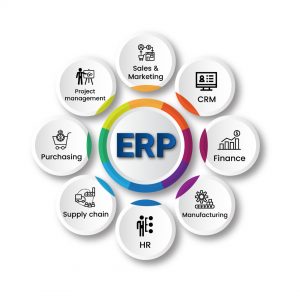ERP, or enterprise resource planning, is a system that enables organizations to manage their resources and integrate them with business processes. It’s been around for decades now, but what exactly is ERP? And why do companies need it? In this guide we’ll answer these questions and provide more details about how ERP works.
Definition of enterprise resource planning (ERP)
Enterprise resource planning (ERP) is a software application that integrates all the business functions within an organization.Enterprise Resource Planning (ERP) encompasses various facets of a company’s operations, such as finance, production and distribution, human resources management, customer relationship management (CRM), supply chain management, and more. It serves as a comprehensive solution used by businesses of all sizes to automate critical processes, enabling them to concentrate on business growth.
ERP systems can be implemented through various methods, but the most common approach involves installing a software package on company servers. This configuration enables employees to access the system anytime and from anywhere, as long as they have an internet connection.
What is an ERP system?
ERP, or Enterprise Resource Planning, is a business management system that integrates all the functions of an organization. It provides a holistic view of the entire business and enables an organization to make better decisions by providing real-time data from which you can see how each part of your operation affects other parts.
ERP systems are used to manage the flow of materials, information and finances within an organization. They help streamline operations so they run more efficiently by automating manual tasks such as order processing or accounts payable processing.
ERP systems are designed to be customizable and scalable, so they can be tailored to fit the needs of any organization. However, not all ERP systems are created equal. Some provide more functionality than others and can cost more or less depending on their features.
ERP systems are usually purchased from a vendor and installed on-premises. However, there is also a growing trend toward cloud-based ERP solutions that allow companies to pay for only the features they need and use them on any device via an internet browser. The following are some of the most popular ERP systems in use today.
What’s the difference between ERP and financials?
ERP systems are business process management systems, designed to manage the entire business. They’re designed to integrate with other systems and automate processes, helping you improve performance across your company.
Financial systems, on the other hand, are also important, but they’re focused on one specific area of your business: accounting. This means that while an ERP system can handle all aspects of running a company (from sales to purchasing), financials will only help out with accounting tasks like keeping track of money coming into or going out of a company’s bank account.
ERP fundamentals
ERP is an integrated system of software applications that automates business processes and helps organizations to manage their operations more efficiently.
ERP systems are designed to help companies improve the way they work by streamlining business processes and automating manual tasks, such as order entry or inventory management. ERP offers benefits including improved productivity, reduced costs and better customer service through real-time data sharing between employees across departments or global locations
The business value of ERP
ERP is a system that provides a single source of truth for all your enterprise data. It enables you to make better decisions faster, improve customer experience, and achieve your business goals.
ERP provides a single source of truth because it consolidates all data into one system including financials and other systems like CRM or HR, meaning that no matter where you look in the company, everyone has access to the same information at all times. This makes it easier for employees at every level of management within an organization to make informed decisions based on reliable information.
A brief history of ERP
ERP, an acronym for Enterprise Resource Planning, originated in the 1960s primarily within manufacturing companies. However, it quickly became evident that ERP technology held significant potential for enhancing business operations across various industries. As more businesses embraced ERP systems, the importance of standardization across industries and geographies became apparent. This recognition led to a growing need for establishing common practices and frameworks to ensure that organizations from diverse sectors could derive maximum benefits from these solutions. In response, standards such as ANSI/X12-ARUP 959 were developed by IBM and General Electric (GE) in collaboration with other big players like Microsoft at the time–and they still stand today!
The first version of ERP was called the Integrated Data Store. It was used by General Electric and IBM to manage the operations of their companies, which included financial management, human resources management, manufacturing and distribution control. At the time, there were no standards for this technology—which is why IBM and GE developed the ANSI/X12-ARUP 959 standardization framework with other big players like Microsoft at
ERP deployment models: From on-premises to the cloud
ERP is a business software solution that helps you manage your entire enterprise, including finance, accounting and human resources. It’s also known as enterprise resource planning (ERP).
The first ERP systems were developed in the late 1960s by large companies like IBM and SAP. These large on-premises systems were installed on mainframes in corporate data centers and required significant investments of time and money to install, configure and maintain them.
As technology advanced over time, ERP vendors began offering cloud-based solutions, software as a service (SaaS) or platform as a service (PaaS). These solutions are hosted by third parties who provide both infrastructure support as well as hosting services for applications running on their servers.
Cloud ERP—A new ERP delivery model
Cloud ERP is a new ERP delivery model that offers many benefits over traditional on-premises solutions. Cloud ERP is a good fit for many businesses, but it’s not right for every business.
Conclusion
ERP has been around for decades, but the way we use it has changed. The cloud is making ERP more accessible and affordable, so that businesses can be more competitive in today’s fast-moving economy. The benefits of ERP are clear: It improves efficiency, reduces errors and waste and ultimately helps companies grow their profits by keeping them on track with their goals

